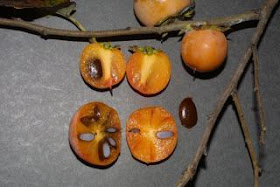Fruit Warehouse | American Persimmon ( Diospyros virginiana ) | Typically Fruiting begins when the tree is about six years old. In the American South and Midwest, the fruits are Referred to as simply persimmons or 'Simmons', and are popular in desserts and cuisine. Commercial varieties include the very productive Early Golden, the productive John Rick, Woolbright, and Miller and the Ennis-seedless variety. Another nickname of the American persimmon, the 'date-plum', actually refers to a variety of persimmon found in South Asia, Diospyros lotus. Diospyros virginiana, commonly called the American persimmon, common persimmon, Eastern persimmon, " simmon "and" possumwood ", is a persimmon species known by a variety of names Including. The tree Grows wild but has been cultivated for its fruit and wood since prehistoric times by Native Americans
The entire tree has oval leaves, and unisexual flowers on short stalks. The fruit-stalk is very short, bearing a subglobose fruit an inch in diameter or a bit larger, of an orange-yellow color, ranging to Bluish, and with a sweetish astringent pulp. It is surrounded at the base by the persistent calyx-lobes, in the which increase of size as the fruit ripens.
The tree Prefers light, sandy, well-drained soil, but will grow in rich, southern, bottom lands. Some trees in the south That Produce fruit is delicious without the action of the frost, while adjoining trees Produce That Never Becomes edible fruit. It was Brought to England before 1629 and is cultivated, but rarely if ever ripens its fruit. It is a common misconception persimmon fruit needs frost to ripen and Soften. Frost, however, destroys the cells within the fruit, Causing it to rot instead of ripen. Only completely RIPE and soft fruit can stand some frost; it will then dry and Become even sweeter (Hence the misconception). The same goes for the oriental persimmon (Diospyros feet), where early frost can severely damage a fruit crop.
The peculiar characteristics of its fruit have made the tree well known. Folklore states That frost is required to make it edible, but fully ripened fruit lightly shaken from the tree or found on the ground below the tree is sweet, juicy and delicious. The fruit is high in vitamin C. The unripe fruit is extremely astringent. The RIPE fruit may be eaten raw, cooked or dried. Molasses can be made from the fruit pulp. Other popular uses include desserts pies Such as persimmon, persimmon pudding, persimmon or candy.
The entire tree has oval leaves, and unisexual flowers on short stalks. The fruit-stalk is very short, bearing a subglobose fruit an inch in diameter or a bit larger, of an orange-yellow color, ranging to Bluish, and with a sweetish astringent pulp. It is surrounded at the base by the persistent calyx-lobes, in the which increase of size as the fruit ripens.
The tree Prefers light, sandy, well-drained soil, but will grow in rich, southern, bottom lands. Some trees in the south That Produce fruit is delicious without the action of the frost, while adjoining trees Produce That Never Becomes edible fruit. It was Brought to England before 1629 and is cultivated, but rarely if ever ripens its fruit. It is a common misconception persimmon fruit needs frost to ripen and Soften. Frost, however, destroys the cells within the fruit, Causing it to rot instead of ripen. Only completely RIPE and soft fruit can stand some frost; it will then dry and Become even sweeter (Hence the misconception). The same goes for the oriental persimmon (Diospyros feet), where early frost can severely damage a fruit crop.
The peculiar characteristics of its fruit have made the tree well known. Folklore states That frost is required to make it edible, but fully ripened fruit lightly shaken from the tree or found on the ground below the tree is sweet, juicy and delicious. The fruit is high in vitamin C. The unripe fruit is extremely astringent. The RIPE fruit may be eaten raw, cooked or dried. Molasses can be made from the fruit pulp. Other popular uses include desserts pies Such as persimmon, persimmon pudding, persimmon or candy.





No comments:
Post a Comment